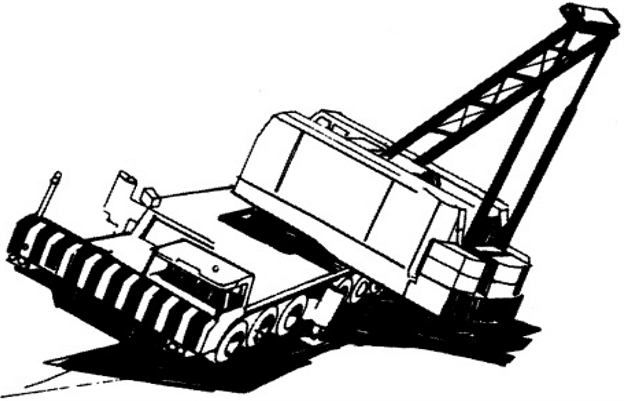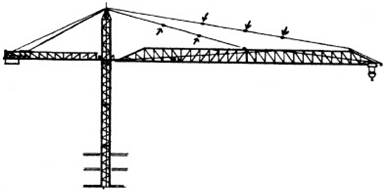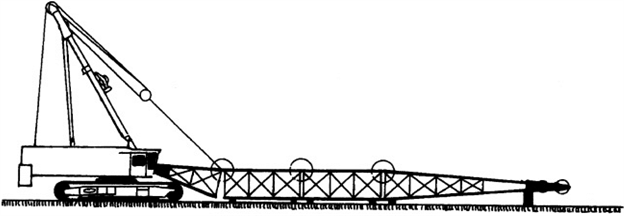(1) When assembling and disassembling crane/derrick (or attachments), you must comply with all applicable manufacturer prohibitions and must comply with either:
(a) Manufacturer procedures applicable to assembly and disassembly; or
(b) Employer procedures for assembly and disassembly. Employer procedures may be used only where you can demonstrate that the procedures used meet the requirements in subsection (17) of this section.
Note: | You must follow manufacturer procedures when you use synthetic slings during assembly or disassembly of cranes/derricks, see subsection (19) of this section. |
(2) Supervision - Competent/qualified person.
(a) Assembly/disassembly must be directed by a person who meets the criteria for both a competent person and a qualified person, or by a competent person who is assisted by one or more qualified persons (assembly/disassembly director).
(b) Where the assembly/disassembly is being performed by only one person, that person must meet the criteria for both a competent person and a qualified person. For purposes of this part, that person is considered the assembly/disassembly director.
(3) Knowledge of procedures. The assembly/disassembly director must understand the applicable assembly/disassembly procedures.
(4) Review of procedures. The assembly/disassembly director must review the applicable assembly/disassembly procedures immediately prior to the commencement of assembly/disassembly unless the assembly/disassembly director has applied them to the same type and configuration of crane/derrick (including accessories, if any).
(5) Preassembly inspection.
(a) Prior to assembling crane/derrick components or attachments the assembly/disassembly director must inspect these components and attachments to ensure that they meet the manufacturer's recommendations. This inspection must include a visual inspection to ensure that the components and attachments are of sound physical condition and functional within the manufacturer's recommendations.
(b) Documentation of this inspection must remain at the job site while the crane/derrick is in use.
(6) Crew instructions.
(a) Before commencing assembly/disassembly operations, the assembly/disassembly director must ensure that the crew members understand the following:
(i) Their tasks;
(ii) The hazards associated with their tasks;
(iii) The hazardous positions/locations that they need to avoid.
(b) During assembly/disassembly operations, before a crew member takes on a different task, or when adding new personnel during the operations, the requirements in (a)(i) through (iii) of this subsection must be met.
(7) Protecting assembly/disassembly crew members out of operator view.
(a) Before a crew member goes to a location that is out of view of the operator and is either: In, on, under, or near the crane/derrick (or load) where the crew member could be injured by movement of the crane/derrick (or load), the crew member must inform the operator that they are going to that location.
(b) Where the operator knows that a crew member went to a location covered by (a) of this subsection, the operator must not move any part of the crane/derrick (or load) until the operator is informed in accordance with a prearranged system of communication that the crew member is in a safe position.
(8) Working under the boom, jib or other components.
(a) When pins (or similar devices) are being removed, employees must not be under the boom, jib, or other components, except where the requirements in (b) of this subsection are met.
(b) Exception. Where you demonstrate that site constraints require one or more employees to be under the boom, jib, or other components when pins (or similar devices) are being removed, the assembly/disassembly director must implement procedures that minimize the risk of unintended dangerous movement and minimize the duration and extent of exposure under the boom. (See WAC 296-155-56430, Assembly/disassembly—Working under the boom, jib or other components—Sample procedures for minimizing the risk of unintended dangerous boom movement.)
(9) Capacity limits. During all phases of assembly/disassembly, rated capacity limits for loads imposed on the crane/derrick, components (including rigging), lifting lugs and crane/derrick accessories must not be exceeded.
(10) Addressing specific hazards. The assembly/disassembly director supervising the assembly/disassembly operation must address the hazards associated with the operation, which include:
(a) Site and ground bearing conditions. Site and ground conditions must be adequate for safe assembly/disassembly operations and to support the crane/derrick during assembly/disassembly (see WAC 296-155-53400 (34) through (38) for ground condition requirements).
(b) Blocking material. The size, amount, condition and method of stacking blocking must be sufficient to sustain the loads and maintain stability.
(c) Proper location of blocking. When used to support lattice booms or components, blocking must be appropriately placed to:
(i) Protect the structural integrity of the crane/derrick; and
(ii) Prevent dangerous movement and collapse.
(d) Verifying assist crane loads. When using an assist crane, the loads that will be imposed on the assist crane at each phase of assembly/disassembly must be verified in accordance with WAC 296-155-53400(61) before assembly/disassembly begins.
(e) Boom and jib pick points. The point(s) of attachment of rigging to a boom (or boom sections or jib or jib sections) must be suitable for preventing structural damage and facilitating safe handling of these components.
(f) Center of gravity.
(i) The center of gravity of the load must be identified if it is necessary for the method used for maintaining stability.
(ii) Where there is insufficient information to accurately identify the center of gravity, measures designed to prevent unintended dangerous movement resulting from an inaccurate identification of the center of gravity must be used. (See WAC 296-155-56430, Assembly/disassembly—Working under the boom, jib or other components—Sample procedures for minimizing the risk of unintended dangerous boom movement.)
(g) Stability upon pin removal. The boom sections, boom suspension systems (such as gantry A-frames and jib struts), and components must be rigged or supported to maintain stability upon the removal of the pins.
(h) Snagging. Suspension ropes and pendants must not be allowed to catch on the boom or jib connection pins or cotter pins (including keepers and locking pins).
(i) Struck by counterweights. The potential for unexpected movement from inadequately supported counterweights and from hoisting counterweights.
(j) Boom hoist brake failure. Each time reliance is to be placed on the boom hoist brake to prevent boom movement during assembly/disassembly, the brake must be tested prior to such reliance to determine if it is sufficient to prevent boom movement. If it is not sufficient, a boom hoist pawl, other locking device/back-up braking device, or another method of preventing dangerous movement of the boom (such as blocking or using an assist crane) from a boom hoist brake failure must be used.
(k) Loss of backward stability. Backward stability before swinging the upperworks, travel, and when attaching or removing crane/derrick components.
 |
Figure 2. Lack of backward stability results in superstructure toppling. |
(l) Wind speed and weather. The effect of wind speed and weather on the crane/derrick.
(11) Cantilevered boom sections. Manufacturer limitations on the maximum amount of boom supported only by cantilevering must not be exceeded. Where these are unavailable, a registered professional engineer familiar with the type of crane/derrick involved must determine this limitation in writing, which must not be exceeded.
(12) Weight of components. The weight of each of the components must be readily available.
(13) Components and configuration.
(a) The selection of components and configuration of the crane/derrick that affect the capacity or safe operation of this equipment must be in accordance with:
(i) Manufacturer's instructions, prohibitions, limitations, and specifications. Where these are unavailable, a registered professional engineer familiar with the type of crane/derrick involved must approve, in writing, the selection and configuration of components; or
(ii) Approved modifications that meet the requirements of WAC 296-155-53400 (58) and (59) (crane/derrick modifications).
(b) Post-assembly inspection. Upon completion of assembly, the crane/derrick must be inspected by the assembly/disassembly director to ensure compliance with (a) of this subsection and as follows:
(i) Upon completion of assembly, the crane/derrick must be inspected by a qualified person to assure that it is configured in accordance with manufacturer's criteria. For tower cranes, this inspection must be done by an accredited crane certifier.
(ii) Where manufacturer's criteria is unavailable, a qualified person must determine if a registered professional engineer (RPE) familiar with the type of crane/derrick involved is needed to develop criteria for the configuration. If an RPE is not needed, you must ensure that the criteria are developed by the qualified person. If an RPE is needed, you must ensure that they are developed by an RPE.
(c) Crane/derrick must not be used until an inspection demonstrates that it is configured in accordance with the applicable criteria.
(d) Documentation of this inspection must remain at the job site while the crane/derrick is in use.
(14) Shipping pins. Reusable shipping pins, straps, links, and similar equipment must be removed. Once they are removed they must either be stowed or otherwise stored so that they do not present a falling object hazard.
(15) Pile driving. Cranes used for pile driving must not have a jib attached during pile driving operations.
(16) The following are additional requirements for dismantling of booms and jibs, including dismantling for changing the length of booms and jibs (applies to both the use of manufacturer procedures and employer procedures):
(a) None of the pins in the pendants are to be removed (partly or completely) when the pendants are in tension. See, for example, Figure 3.
 |
Figure 3. Pins (indicated by arrows) are not to be removed while pendants remain in tension. |
(b) None of the pins (top and bottom) on boom sections located between the pendant attachment points and the crane/derrick body are to be removed (partly or completely) when the pendants are in tension. See, for example, Figures 4 and 5.
 |
Figure 4. Pendant is in tension while connected to uppermost boom section, and no pins are to be removed. |
 |
Figure 5. Pendant is in tension, and pins between pendant attachment point and crane body (indicated by arrows) are not to be removed. Note that, because the cantilevered portion of the boom is not supported, only the bottom pins ahead of the pendant may be removed. See Figure 8. |
(c) None of the pins (top and bottom) on boom sections located between the uppermost boom section and the crane/derrick body are to be removed (partly or completely) when the boom is being supported by the uppermost boom section resting on the ground (or other support). See, for example, Figure 6.
 |
Figure 6. Uppermost boom section is resting on ground, and no pins between uppermost boom section and crane body are to be removed. |
(d) None of the top pins on boom sections located on the cantilevered portion of the boom being removed (the portion being removed ahead of the pendant attachment points) are to be removed (partly or completely) until the cantilevered section to be removed is fully supported. See, for example, Figures 7 and 8.
 |
Figure 7. Cantilevered portion of boom is not supported, and top pins therefore are not to be removed. Bottom pins (circled) may be removed. |
 |
Figure 8. Cantilevered portion of boom is supported, and top pins (circled) may therefore be removed. |
(17) When using employer procedures instead of manufacturer procedures for assembling or disassembling, you must ensure that the procedures are designed to:
(a) Prevent unintended dangerous movement, and to prevent collapse, of any parts of the crane/derrick.
(b) Provide adequate support and stability of all parts of the crane/derrick during the assembly/disassembly process.
(c) Position employees involved in the assembly/disassembly operation so that their exposure to movement or collapse is minimized.
(d) Qualified person. Employer procedures must be developed by a qualified person.
(18) Outriggers and stabilizers. When the load to be handled and the operating radius require the use of outriggers or stabilizers, or at any time when outriggers or stabilizers are used, the following requirements must be met:
(a) The outriggers or stabilizers must be either fully extended or, if manufacturer procedures permit, deployed as specified in the load chart.
(b) The outriggers must be set to remove the crane weight from the wheels, except for locomotive cranes (see (f) of this subsection for use of outriggers on locomotive cranes). This provision does not apply to stabilizers.
(c) When outrigger floats are used, they must be attached to the outriggers. When stabilizer floats are used they must be attached to the stabilizers.
(d) Each outrigger or stabilizer must be visible to the operator or to a signal person during extension and setting.
(e) Outrigger and stabilizer blocking must:
(i) Meet the requirements in subsection (10)(b) and (c) of this section.
(ii) Be placed only under the outrigger or stabilizer float/pad of the jack or, where the outrigger or stabilizer is designed without a jack, under the outer bearing surface of the extended outrigger or stabilizer beam.
(f) For locomotive cranes, when using outriggers or stabilizers to handle loads, the manufacturer's procedures must be followed. When lifting loads without using outriggers or stabilizers, the manufacturer's procedures must be met regarding truck wedges or screws.
(19) Rigging. In addition to the following requirements in WAC 296-155-556, 296-155-558, 296-155-560 and 296-155-562 and other requirements in this and other standards applicable to rigging, when rigging is used for assembly/disassembly, you must ensure that:
(a) The rigging work is done by a qualified rigger. See WAC 296-155-53306.
(b) Synthetic slings are protected from: Abrasive, sharp or acute edges, and configurations that could cause a reduction of the sling's rated capacity, such as distortion or localized compression. See WAC 296-155-55815(6), 296-155-55820(6) and 296-155-55825(6).
Note: | Requirements for the protection of wire rope slings are contained in WAC 296-155-55805. |
(c) When synthetic slings are used, the synthetic sling manufacturer's instructions, limitations, specifications and recommendations must be followed.